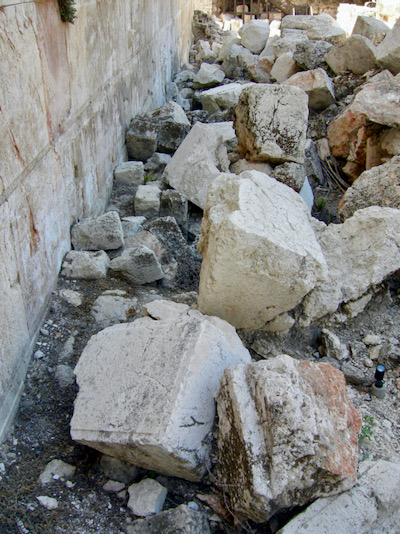
Excavated stones from the Wall of the 2nd Temple (Jerusalem), knocked onto the street below by Roman battering rams in on the 9th of Av, 70 C.E. This first century street is located at the base of the Temple Mount where the western and southern walls meet. The property may be accessed via the Davidson Archeological Center in Jerusalem. (Photo courtesy of Wikipedia.)
DAY BEGINS THE EVENING of SATURDAY AUGUST 6—My introduction to Jon Stewart came on Tisha B’Av about two decades ago. I happened upon The Daily Show just as Stewart was pointing to a Jewish star decorated with lights. He said something like, “Today was a Jewish holiday.” Then the lights on the star went out and he said, “Not that kind of holiday. It was a sad holiday,” and he made that well-rehearsed doleful face, downward smile, creased forehead, puppy dog eyes. I became a Daily Show fan that day and never looked back!
Yes, my friends: that’s Tisha B’Av—a holiday with no lights, no upbeat greeting, and no tasty morsels drenched in oil or filled with cheese. In fact, some people choose to fast for 24 hours, in deference to the somber quality of the day.
Tisha B’Av (the ninth day of the Hebrew month called Av) memorializes the sacking of Jerusalem, the destruction of its central Temple in 586 BCE, and again (having been rebuilt in the interval) in 70 CE, and the exile of the Jewish people from their (home)land twice. Tradition says these events, along with other Jewish tragedies happened on this very day. The accuracy of this tradition notwithstanding, all devastating events in our people’s history are recalled on Tisha B’Av. Observant Jews spend the day in prayer, refrain from pleasurable activities, and chant mournfully from the biblical Book of Lamentations.
In Jewish thought and experience, exile is both physical/historical and metaphysical/spiritual. With the current reality of the State of Israel as a Jewish homeland and place of return, some find greater meaning in contemplating the ahistorical themes of Tisha B’Av: what constitutes exile from God, from our truest selves, from each other. Spending a day mourning what is lost or broken in our lives as individuals and as humanity, might we more successfully find our way back to God or to less fractured lives and relationships with each other and the earth?
It is probably not by accident that Tisha B’Av occurs seven weeks before Rosh HaShanah, the Jewish New Year. Seven is a significant—arguably the most significant—number in Jewish life. Shabbat is celebrated on the seventh day of the week. Rosh HaShanah occurs in the seventh month of our calendar. There are seven blessings recited at a Jewish wedding. The initial mourning period for a loved one is seven days: the number seven appears again and again in Jewish ritual and ceremony.
The passage of seven weeks between Tisha B’Av, day of intense reflection, sorrow and contemplation of loss and exile, and Rosh HaShanah, day of new beginnings, celebration and joyful prayer, indicates the life-affirming, stubbornly hopeful stance at the core of Judaism. It suggests that we not be paralyzed by guilt or sadness or loss, but that we muster our communal and personal resources to assess what was or what is, and progress from there.
Tisha B’Av instructs: Look at the pain of the world (and personal pain) realistically, see its (and our) fractures, face those fractures…..and move forward. In the poignant words of Rabbi Lev Meirowitz Nelson, “Claw your way back to a place where we can enter the new year, seek forgiveness and start afresh.”
It is a good thing, in my opinion, to stake out a day devoted to confronting our fractured lives on this fractured planet.
From the Book of Lamentations 1:16 “For these things I weep, my eye sheds tears…” The tears we shed literally or figuratively for people in crisis resulting from war, hunger, disease, abuse, false incarceration, violence. For children bullied or shamed, for teens rejected for their sexuality, for couples devastated by infertility, for partners undone by broken trust, for dreams dashed by accidents and illnesses, for people who cannot forget, for people who cannot remember, for pain unassuaged. Life’s cruelty abounds. No one escapes this life unscathed.
And yet we cannot live endlessly in a place of bitterness and despair, or in fear that catastrophe awaits us at any turn. We are called to remember, recover, reach out and regenerate. Not to live blindly in denial, but never to stop believing that the future can redeem the past. That is the lesson of Rosh HaShanah, an affirmation of creation and possibility, following seven weeks after Tisha B’Av, with its sobering lessons.
It is surprising—one could say astounding—that Jews remain a hopeful people. For most of our history, we have been subject to prejudice, dispersion and brutality, and few would question if we had become a dejected, languishing people, a people estranged from laughter and joy. But in fact, the opposite is true: Many Jews consistently look out for something to laugh about (including ourselves), something to care about (societal ills and people living on the fringe), and ways to be creative and purposeful. When we life our glasses, we toast, “L’Chayim,” “To Life.”
This is one of the many reasons I love Judaism: it teaches us to acknowledge the pain, and it expects us not to be overcome by it. To wrestle a blessing out of a curse. To believe in, and to work towards, a world of fairness and beauty and possibility.
Tisha B’Av is not a day of dread and it is not a day I dread. It is a day to contemplate loss and exile. It is a day to start the journey back home.
.
.
Meet Rabbi Lenore Bohm …
 VISIT RABBI LENORE’S RESOURCE PAGE: Go to TorahTutorBook.com to find more information about her ongoing work and her new book.
VISIT RABBI LENORE’S RESOURCE PAGE: Go to TorahTutorBook.com to find more information about her ongoing work and her new book.
Order a copy of her new book from Amazon.

Tell Us What You Think